#thinking i might need to rewatch klk too...
Explore tagged Tumblr posts
Note
going and back and rereading your kill la kill meta, I should definitely rewatch kill la kill
I'm so flattered that there's still interest in my old meta all these years later! And that they encourage looking back at the series? 🥺
Thank you for revisiting them! Hope you enjoy the rewatch!
#amber gimlet#replies#thinking i might need to rewatch klk too...#*finally* started ripping my klk blu-rays because i want to *finally* make that amv haha#and i still follow the klk tag on here and so sometimes i'm recommended posts from the tag#and lately it's been meta i completely disagree with?#and of course everyone is free to interpret fiction as they like! i'm not saying that my takes are more 'valid' or anything#every work of fiction will be important to people in different ways#but my takes are so wildly different from the popular ones being recommended at me that i'm just ^^;#i really feel like i watched this show wrong or something haha#and maybe i'd feel differently if i rewatched it#i dunno ^^;#that's probably enough rambling! it's really sweet that even all these years later my meta's getting looked at thank you <3
6 notes
·
View notes
Text
This is written well. You mentioned the reviews of KLK, so I will pull what I believe to be representative of what "saving anime" was supposed to be:
It's been said by many veteran anime watchers that anime is dying. In the old days we had our Cowboy Bebop, Trigun, Wolf's Rain, Neon Genesis Evangelion, Akira, FLCL, Berserk, Fist of the North Star, and Miyazaki; we had Space Captain Harlock, Lupin the Third, Yu Yu Hakusho, and Ghost in the Shell. Even if you haven't seen these, you've likely at least heard of them and the impact that they've had on anime as a whole. Anime was an intellectual, creative medium that reflected flair and pizzazz. It wasn't just silly entertainment for kids, like many Western cartoons, and people of all ages could enjoy it. As of late it seems that anime has been stuck in a rut of moe, harems, rom-coms with unrealistically dense male MC’s, and onii-chan/imouto obsessive garbage. Lately there's been a lack of courage to sack up, step outside of the box, and say, "Hey, let's try something new." After you peruse season after season of the same regurgitated genres you might find yourself wondering if anime has lost its way... And, to answer that question, Trigger will look down and whisper, "No."
If you don't think that anime needed saving, that's fine.
If you don't think Trigger saved anime, that's fine.
If you don't like KLK, that's fine too.
I'd have to rewatch KLK to be sure, but I think some of the tropey stuff you point out is supposed to be over-the-top and ridiculous in a tongue-in-cheek way. Just as Gamagori looming over the student in the first episode is supposed to be exaggerated, so are Mako's monologues about the Ryuko and the power of friendship:
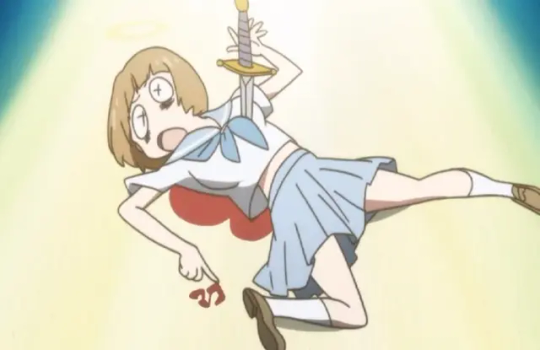
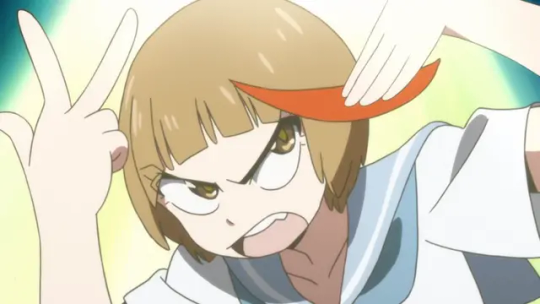
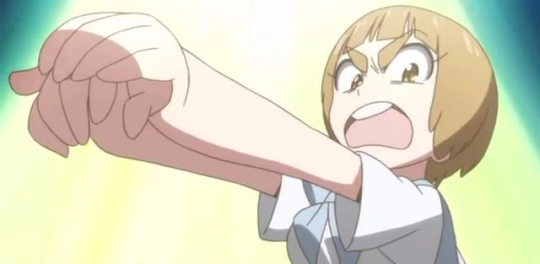
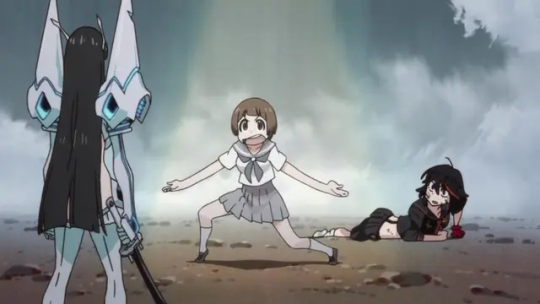
...or whatever else happens to be the subject:

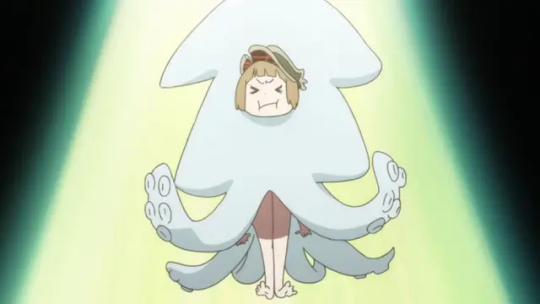
It's a gag.
Kill la Kill (anime)

So, twelve years on, did Trigger save anime?
Existing in the present will invariably inundate one with lifeless, disposable, trend-chasing pop media, no matter the medium. Not only do moneymen like to imitate whatever made money before, but artists like to imitate the art they enjoy. The current moment will always seem bloated by dreck, while the past, filtered via the sieve of time, will always seem to contain only gleamingly original works of greatness. Were the 1980s not a golden age of blockbuster cinema, with Aliens and Indiana Jones and Ghostbusters? Please ignore the 1,000 shoddy E.T. knockoffs, thank you, or the million formulaic action hero flicks aping the Schwarzenegger formula.
Anime in 2013, when Kill la Kill began airing, was no different. The past two years had seen Puella Magi Madoka Magica, Hunter x Hunter, Fate/Zero, Stein's;Gate, Kuroko no Basket, Nichijou, Nisemonogatari, Psycho-Pass, and Attack on Titan, all popular and well-regarded shows both when they released and today. So the memetic idea in the anime community that Trigger was "saving anime" with Kill la Kill is patently ridiculous. (If you don't believe how widespread this idea was, two of the three top reviews for the show on MyAnimeList, written the same day the show finished airing, allude to it.)
It's easy to see how the idea became so popular, though. Trigger was a brand new studio formed primarily by staff from debt-stricken Gainax, the legendary studio that in 1995 revolutionized anime with Neon Genesis Evangelion. Eva's main creative figure, auteur director Hideaki Anno, wasn't with Trigger, but many of the people behind Gainax's other popular shows like Gurren Lagann and Panty & Stocking were, so the studio had a new-look fresh-start feel while drawing on a proven lineage of success.
At the same time, Kill la Kill itself promotes its revolutionary nature. Its plot revolves around a lone rulebreaking badass taking on an entrenched system defined explicitly by its aesthetic uniformity. It's not a difficult leap to read this storyline metaphorically, Trigger battling the waves of copy-paste seasonal anime.
However, what is most striking, most obviously eye-catching and unique about Kill la Kill, what hits the viewer with the immediate sense that this show is something different, something new, something like nothing you have seen before, is that it looks like nothing you have seen before. Kill la Kill is brimming with unique and memorable images, from the gigantic red block text used to introduce every new character and concept, to the bizarre ship-like architecture of Honnouji Academy, to the blend of fluid sakuga with choppy PowerPoint animation for comedic effect, to smaller iconic moments like Satsuki clicking her heel. It's always in-your-face about it, too. The opening scene sets the tone when a dry history lecture gets interrupted by Gamagoori squeezing through a door like a behemoth, utterly ignoring any rules regarding on-model consistency.
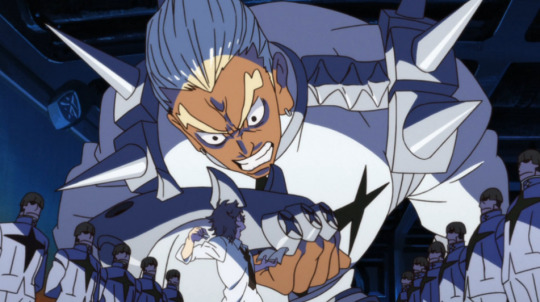
It's this devotion to the unique image that sets Kill la Kill apart from most of the other 2011-2013 shows I listed previously, shows that, while they might have a consistent aesthetic sensibility (such as Stein's;Gate's washed-outness or Fate/Zero's glimmering post-processing effects), are often conforming at their core to ideas of what anime "should" look like in terms of character design, setting, and animation. (The two Shaft shows I listed are an exception, but by this point Shaft's Akiyuki Shinbo had been doing his idiosyncratic visual style for over a decade, and wasn't exactly a fresh face.) Trigger's staff previously created Panty & Stocking, a show imitating the look and feel of western cartoons; Kill la Kill advances that idea into a wholly unique fusion of western and Japanese animation traditions, allowing it to break free of the insular anime landscape and its expected visual signifiers.
Obviously the counterpoint lurking beneath this preamble is that, under the unique visuals and tone, Kill la Kill isn't all that innovative at all, even painfully standard at times. Battles are decided by the power of friendship or the power of staying true to oneself (Don't Lose Your Way!), the hero is mind controlled and her friends call out to her until she breaks free, the one-dimensionally evil villain has a big end-the-world plot that everyone teams up to defeat. Even within the parameters the story establishes for itself, Ryuko proceeds linearly, starting out by fighting small fry club captains, then the Elite Four student council, then Satsuki the student council president, and finally Satsuki's mother who owns the school, with only a few speed bumps along the way.
But Kill la Kill makes the argument that aesthetics are too intimately interwoven with content to be disentangled that way. It's the crux of the conceit of the show, which is founded on a series of puns. "Fascism" sounds like "fashion," so in the world of Kill la Kill those concepts are now entwined. "School uniform" ("seifuku") and "conquest" ("seifuku") are homophones, so uniforms are the method by which Satsuki exerts her intra-Japanese imperialism. (Early on, Satsuki delivers a monologue in which she remarks on how Japanese school uniforms are aesthetically modeled on military uniforms, making it natural for her to militarize her school.) The title is itself a tripartite pun, combining words for "kill," "cut," and "wear." (Notably, this is a pun that blends the English and Japanese languages, much like the blended animation style.) Despite the visual, slapstick nature of Kill la Kill's humor, puns abound throughout. Some are obvious even in translation, such as the "Naturals Election" used to choose the new student council, while others can be difficult to catch. Nui, for instance, apes Dio Brando's catchphrase of "muda, muda, muda" (useless, useless, useless); later, when her arms are cut off, she screams "ude, ude, ude" (arms, arms, arms).
youtube
The core idea of most of these puns is that superficial similarity indicates similarity of content. Sometimes, this is an insightful observation, such as with the pun between fashion and fascism. Fascism is notoriously difficult to define rigidly in relation to other forms of dictatorship, but what is easy to define about it is its aesthetics, to the point that films like Star Wars are able to use aesthetic signifiers of fascism to define the politics of its villains even when withholding any actual explanation of those politics. Star Wars never has to show what the day-to-day rule of the Empire is like, because its army looks like the Nazis, so the audience gets the idea. Fascism as a political ideology and fascism as an aesthetic are, effectively, the same thing.
And if aesthetics are equivalent to meaning, then doesn't that mean that Kill la Kill looking new in fact makes it new? That its plot, generic in dry summary, is elevated by the distinctive way it's depicted? One pun, delivered upon the revelation that parasitic alien clothes have influenced humanity's evolution for the purpose of harvesting them for food (a story beat itself derivative of Puella Magi Madoka Magica), is that "the clothes make the mankind." The common refrain of Satsuki and Ragyo that people are "pigs in human clothing" hammers the point home: Aesthetics are everything. There is no meaning without aesthetics, just as people without clothes are unevolved animals.
Ultimately, though, Kill la Kill rejects this statement. Clothes are the enemy, literally, and the heroic organization fighting against them is Nudist Beach, whose members fight naked. At the end of the show, all clothes are destroyed, and the final image before the credits is of the entire cast in a giant, naked, triumphant huddle, an assertion of the inherent value of humanity even without aesthetic adornment. Isn't that the point behind all those power-of-friendship, power-of-believing-in-yourself speeches that Ryuko, Mako, and Senketsu use to turn the tables and win the battle? An appeal to a hidden inner nature that one must remain true to (Don't Lose Your Way!!!), that can overpower superficial displays of strength? Ryuko's mind control arc depicts this idea most overtly. She is controlled by having clothes sewn to her skin -- having an aesthetic forced onto her -- but Mako manages to dive into Ryuko's inner world to bring her back to her "true self."
This kind of undermines Kill la Kill as a work, though. What does a "nudist" Kill la Kill look like, stripped of its unique visual language? Certainly not something that would stand out from the waves of high school battle shounen that have been a fixture in the anime landscape since time immemorial. Kill la Kill's thesis might assert that there's a reason these power-of-friendship cliches endure (a sort of, if you'll allow me to become a parody of myself for a moment, post-postmodern reclamation of a narrative mode tarnished by irony and cynicism), but it contradicts the unique visual style that Kill la Kill developed to convey that idea.
In some ways, Kill la Kill does strip down to a nude, or at least semi-nude, state by the end. Many of its earlier concepts, including the connection between fashion and fascism, vanish as the story progresses. Satsuki and her fascist system are revealed to have been a deception while she secretly worked to betray her mother (playing on Ragyo's mistaken belief that aesthetics mean everything by Satsuki looking compliant while not actually being so), and once the twist occurs, the entire fascism plotline goes out the window. It's never really mentioned again; even when Ryuko gets on Satsuki's case for her past misdeeds, she only calls her out for "Looking down on people from on high," a general and ideologically-agnostic call against elitism. The 1-episode OVA set after the series briefly touches on the fascist system Satsuki enforced, with the episode's villain accusing Satsuki and the Elite Four of generating real, actual terror and abuse despite their ultimately pure motives (an assertion, once more, that aesthetics mean everything, that looking fascist makes you fascist no matter your true beliefs), but Mako quickly dismisses the claim with another power-of-friendship speech. Satsuki and the Elite Four have grown as people, she says. They're no longer bad like they used to be!
Kill la Kill also gets stripped down tonally by its end. The show's opening scene depicts a disobedient student being whipped, seemingly to death; later, his nude corpse(?) is displayed over the school gates. Combined with the title "Kill la Kill," it sets a dark, violent tone that lends weight to the otherwise cartoonish animation style. By the end, though, this dark tone is revealed as a false aesthetic; there is remarkably little killing in Kill la Kill. Stripped of real narrative stakes, the climactic battles diminish to flashy lightshows, action figures bouncing against each other. Worst of all, the blend of "fluid sakuga with choppy PowerPoint animation" I mentioned earlier increasingly tilts toward the latter. This is largely due to the prominence of Nui as an antagonist, since her cartoonishness is part of her character, but given Gainax's track record of running out of money and/or time by the end of its shows and phoning in parts of them, I wonder whether the habit transferred over to Trigger.
In short, as Kill la Kill strips down, it becomes a weaker show. In doing so, it not only undermines its own theme, but undermines itself as a truly new and innovative work, exposing its reliance on superficial aesthetic. The notion that Trigger "saved anime" would depend not only on Kill la Kill's individual success, but on its influence; twelve years out, and the only other notable shows like Kill la Kill were also made by Trigger. Perhaps you can see some influence on Masaaki Yuasa, who also blends high-quality sakuga with deliberately cheaper animation for comedic or stylistic effect, but he had already established himself in 2010 with Tatami Galaxy. Another show with a distinctive "Trigger" feel, Flip Flappers, was a flop flopper that caused its studio to immediately pivot to generic seasonal stuff.
My friend Lurina, when I asked her whether Trigger really had any influence over the larger anime landscape, suggested that Trigger sparked a general desire for more high-quality animation, which can be seen today in shows like Chainsaw Man or Dandandan. I would counter that those shows, while well-made, lack the distinctive blend of high and low, east and west that defines Trigger; if anything, the notion of the high-quality seasonal shounen adaptation comes from My Hero Academia, where Bones eschewed the traditional 500-episode weekly low-effort adaptation style of Naruto, Bleach, and One Piece and set the blueprint for shows like Demon Slayer, Jujutsu Kaisen, and so on, which adapt their source material in 12-episode chunks with lavish production values.
At the same time, I question whether Trigger even saved itself. Kill la Kill would be the studio's peak, and much of its subsequent output is a pale shadow of the show. (Its only other megahit, Darling in the Franxx, had an even more disastrous ending.) This culminated in BNA, a show that takes Kill la Kill's themes and iconography but does them cheaply and lazily. Since then, Trigger has rebounded -- but not by being "Trigger." Cyberpunk Edgerunners and Dungeon Meshi were both popular and well-regarded shows, but they were adaptations where Trigger had minimal control over the storytelling or aesthetic; Dungeon Meshi, other than a few sparse sakuga moments, doesn't even look distinctively like a Trigger show. It feels like any competent studio could have turned Dungeon Meshi into a hit. Trigger still exists, and in its partnership with Netflix is possibly stronger than ever, but it is losing its unique identity, becoming more standard, more similar to the crowd. Another conformer. Maybe the upcoming Panty & Stocking sequel can turn it around, but who can say.
Either way, Kill la Kill's moment has passed, without the cataclysmic ripple on the anime industry fans at the time expected or craved. Honestly, though, despite how I opened this essay, I can't blame them for their desire to see anime "saved." After all, the biggest anime of 2012, the year before Kill la Kill aired, did cause a cataclysmic ripple, one undoubtedly felt to this day. Unlike Kill la Kill, the biggest anime of 2012 spawned countless imitators, an endless flood of imitators, imitators that have themselves spawned imitators and imitators of imitators. That anime of 2012 has even extended its reach past anime, coating the current webfic scene; one could say that the site RoyalRoad would not exist if not for it. In face of such an oppressive, daunting influence, perhaps those fans of 2013 were right to clamor for something, anything, that would reveal a new direction, a way out. In such a context, one might even see it as tragic that Kill la Kill failed to deliver, that at the last moment it came up short. If Kill la Kill was the fork in the road leading to sunnier pastures, this anime led the industry into a deep, dark forest.
The name of that anime?
Sword Art Online.
270 notes
·
View notes
Text
ok so i own the ORIGINAL gits movies... the first two, gits and :innocence. nice? nice. oh yea, thats the classic one, i know what the first one is now, ive seen clips of it. its just you mostly here gits talked about in relation to stand alone complex soooo wasnt sure what was up.
but yea. fuck it. ill watch ghost in the shell 1995 tomorrow after ive gone for a walk. id watch it during the day buuuttt chels will be home and shell either be on the couch doing jack all or shell play the ps4, both of which stop me watching The Animes
#i mean technically i could also watch fma:b tomorrow during the day.......... and i honestly might. get back to me on that#i only watched 4 eps and theres like 30 odd so i gotta get to work. wanna add more completed anime to the list#i have a lot of anime i need to watch. theres uh.... konosuba..... mirai nikki (for somewhat obvious shitty reasons).... chivalry?#i think ill watch chivalry of a failed knight because fuck it. anime. wanna rewatch and finish klk. gurenn lagann. yknow. all the anime#death note. need to watch death note too. still havent seen that. im really out of touch with anime alright#i exclusively watched anime from the late 90s early 00s and then exclusively whichever season had attack on titan in it
0 notes